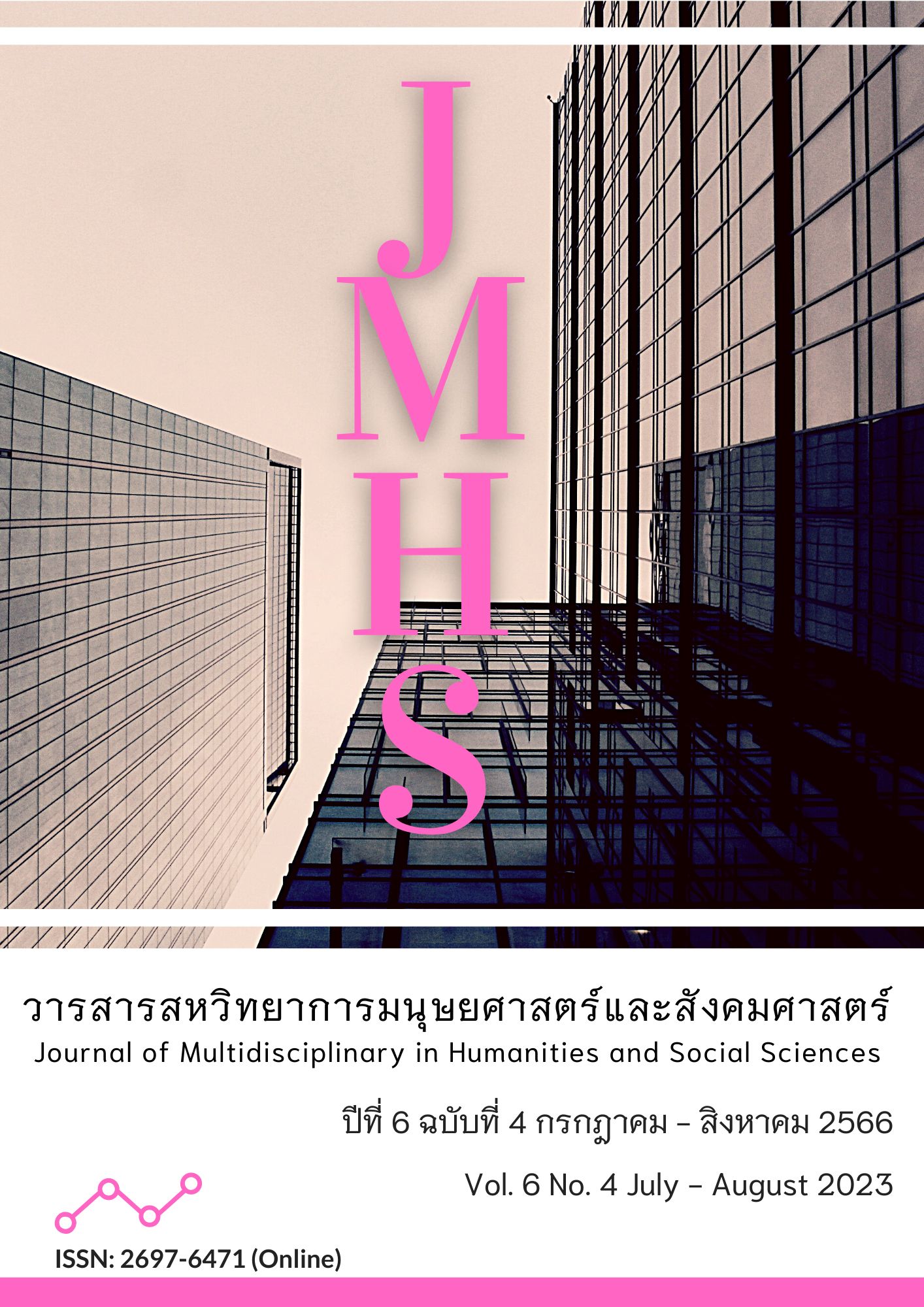Causal Factors Influencing Purchase Intention Organic Food on Facebook Pages of Consumers in Bangkok and Its Vicinity
Main Article Content
Abstract
The article aimed to 1) develop and validate a causal of relationship model of purchase intention organic food on Facebook pages of consumers in Bangkok and its vicinity ; and 2) find causal factors affecting purchase intention organic food on Facebook pages of consumers in Bangkok and its vicinity. This study was a quantitative research. The sample was people who have bought organic food via Facebook Pages and live in Bangkok and its vicinity of 400 people by convenience Sampling technique. The tools used in the research was online questionnaires. The statistics used in data analysis were frequency, percentage, confirmatory factor analysis and structural equation model.
The results of this research were the development of the causal relationship models consisted of 4 components which are 1) e –word of mouth 2) perceived risk 3) trust and 4) purchase intention and the model is consistent with the empirical data to a great extent. The statistic shows CMIN/df = 2.18, GFI = 0.93, AGFI = 0.90, SRMR = 0.05, RMSEA = 0.06. The final is predictive coefficient of 0.76, indicating that the variables in the model can explain the variance of the purchase intention on Facebook Pages by 76 percent. It was found that trust, factor perception risk and electronic word of mouth communication are a factor that influences purchase intention respectively. Which entrepreneurs who sell organic food should take into account the trust of consumers. This will lead to electronic word of mouth causing the intention to continue buying organic food on the Facebook page.
Article Details

This work is licensed under a Creative Commons Attribution-NonCommercial-NoDerivatives 4.0 International License.
Views and opinions appearing in the Journal it is the responsibility of the author of the article, and does not constitute the view and responsibility of the editorial team.
References
ชลลดา มงคลวนิช. (2563). ปัจจัยความเชื่อมั่นที่มีอิทธิพลต่อการตัดสินใจซื้อสินค้าออนไลน์ของเยาวชนไทย. วารสารมนุษยศาสตร์วิชาการ, 27(2), 189-214.
ชัญญา ชีนิมิต และ พัชนี เชยจรรยา (2559). ปัจจัยที่มีผลต่อการตัดสินใจซื้ออาหารออร์แกนิคออนไลน์ของผู้บริโภค. วารสารการสื่อสารและจัดการ นิด้า, 2(3), 1-11.
ดารินทร์ จิตสุวรรณ. (2561). อิทธิพลของการสื่อสารปากต่อปากแบบอิเล็กทรอนิกส์ต่อความตั้งใจเลือกใช้บริการโรงแรมที่พักในประเทศไทย. วารสารระบบสารสนเทศด้านธุรกิจ, 4(1), 22-33.
ทิวาวรรณ ศรีสวัสดิ์, ภัทราวดี มากมี และ พูลพงศ์ สุขสว่าง. (2559). โมเดลความสัมพันธ์เชิงสาเหตุของการเกี่ยวข้องกับสถานการณ์และความไว้วางใจที่มีต่อการตั้งใจเลือกซื้อจากร้านค้าออนไลน์ของผู้บริโภคชาวไทย. วารสารวิทยาลัยพาณิชศาสตร์บูรพาปริทัศน์, 11(2), 31-46.
ปาณิศา ศรีละมัย และ ศุภชาต เอี่ยมรัตนกูล (2561). อิทธิพลของความไว้วางใจที่มีต่อการตัดสินใจซื้อผลิตภัณฑ์ทำความสะอาดผิวหน้าที่มีส่วนผสมจากธรรมชาติผ่านร้านค้าปลีก. วารสารสหวิทยาการวิจัย ฉบับบัณฑิตศึกษา, 7(2), 69-78.
เปมิกา แป้นประดิษฐ์, ยุพาภรณ์ อุไรรัตน์ และพิเชษฐ์ พรหมใหม่. (2564). อิทธิพลของทัศนคติปัจจัยด้านสังคมและความไว้วางใจที่มีต่อความตั้งใจซื้อประกันชีวิตของประชาชนในจังหวัดสงขลา.วารสารบริหารธุรกิจ มหาวิทยาลัยแม่โจ้, 3(2), 20-34.
ภพพรหมินทร์ วโรตม์วัฒนานนท์. (2562). ปัจจัยที่มีอิทธิพลต่อการสื่อสารแบบปากต่อปากในยุค ดิจิทัล. วารสารการสื่อสารและการจัดการ นิด้า, 1(1), 86-100.
มณีรัตน์ แสงบญไทย, สุขุมาล เกิดนอก และ วรญา โรจนาปภาพร. (2565). ปัจจัยเชิงสาเหตุที่มีอิทธิพลต่อการตั้งใจซื้ออาหารออร์แกนิคของผู้บริโภคในประเทศไทย. วารสารศิลปการจัดการ, 6(2), 621-636.
สำนักงานพัฒนาธุรกรรมทางอิเล็กทรอนิกส์. (2564). e-Commerce ไทย ยุคหลัง COVID-19. สืบค้นเมื่อ 15 ธันวาคม 2565, จาก https://www.etda.or.th/th/Useful-Resource/Knowledge-Sharing/Perspective-on-Future-of-e-Commerce.aspx
สำนักงานพัฒนาธุรกรรมทางอิเล็กทรอนิกส์. (2565). รายงานผลการสำรวจพฤติกรรมผู้ใช้อินเทอร์เน็ตในประเทศไทย ปี 2565. สืบค้นเมื่อ 15 ธันวาคม 2565, จาก https://www.it24hrs.com/2022/etda-survey-result-internet-behavior-2565/
สุธีรา เดชนครรินทร์, ธนัญญา ยินเจริญ และ อัคญาณ อารยะญาณ. (2565). บทบาทความไว้วางใจของผู้ซื้อสินค้าในตลาดกลางพาณิชย์อิเล็กทรอนิกส์. วารสารการจัดการสมัยใหม่, 20(1), 28-43.
อภิชยาภรณ์ ชุณหเวชสกุล, ปริญ ลักษิตามาศ และ ชัยพล หอรุ่งเรือง. (2562). การตลาดเชิงสร้างสรรค์และการโฆษณาเชิงเนื้อหาการท่องเที่ยวไทยที่ส่งผลต่อความตั้งใจซื้อของนักท่องเที่ยวชาวจีน ญี่ปุ่นและเกาหลีใต้ในรุ่นเจเนอเรชั่นวาย. วารสารมหาวิทยาลัยศิลปากร, 39(1), 75-92.
อารีรัตน์ ปานศุภวัชร, ประวีณ ปานศุภวัชร และ ญาดา สามารถ. (2563). ผลกระทบของการสื่อสารการตลาดด้วยสื่อสังคมออนไลน์ ความผูกพันของลูกค้า และความภักดีในตราสินค้าที่มีต่อความตั้งใจซื้อผลติภัณฑ์เครื่องสำอางของเจนเนอเรชันวายในประเทศไทย. วารสารการบัญชีและการจัดการ มหาวิทยาลัยมหาสารคาม, 14(3), 36-49.
Allen, I. E., & Seaman, C. A. (2007). Likert Scales and Data Analyses. Quality Progress, 40(7), 64-65.
Becker, M. H., Maiman, L. A., Kirscht, J. P., Haefner, D. P., & Dracman, R. H. (1977). The Health Belief Model and Prediction of Dietary Compliance: A Field Experiment. Journal of Health and Social Behavior, 18, 348-366.
Bhandari, M., & Rodgers, S. (2018). What Does the Brand Say? Effects of Brand Feedback to Negative e-WOM on Brand Trust and Purchase Intentions. International Journal of Advertising, 37(1), 125–141.
Choon, L. K., Daud, D. B., Piew, T. H., Keoy, K. H., & Hassan, P. (2011). Perceived Risk, Perceived Technology, Online Trust for the Online Purchase Intention in Malaysia. International Journal of Business and Management, 6(6), 167-182.
Das, G. (2014). Linkages of Retailer Personality, Perceived Quality and Purchase Intention with Retailer Loyalty: A study of Indian Non-food Retailing. Journal of Retailing and Consumer Services, 21(3), 407-414.
Hair, J. F., Hult, G. T. M., Ringle, C. M., & Sarstedt, M. (2014). A Primer on Partial Least Squares Structural Equation Modeling (PLS-SEM). California, CA: Sage Publications.
Hoelter, J. W. (1983). The Effects of Role Evaluation and Commitment on Identity Salience. Social Psychology Quarterly, 46(2), 140-147.
Howard, J. A. (1994). Buyer Behavior in Marketing Strategy. Englewood Cliffs, NJ.: Prentice Hall.
Hu, L.T., & Bentler, P. M. (1999). Cutoff Criteria for Fit Indexes in Covariance Structure Analysis: Conventional Criteria Versus New Alternatives. Structural Equation Modeling, 6(1), 1-55.
Ilhamalimy, R. R., & Ali, H. (2021). Model Perceived Risk and Trust: e-WOM and Purchase Intention (The role of trust mediating in online shopping in Shopee Indonesia). Dinasti International Journal of Digital Business Management, 2(2), 204-221.
Joreskog, K. G., & Sorbom, D. (1984). Advances in Factor Analysis and Structural Equation Models. Lanham: Rowman & Littlefield Publishers.
Kline, R. B. (2011). Principles and Practices of Structural Equation Modeling. (3rd ed.). New York: The Guilford Press.
Mulcahy, R., Letheren, K., McAndrew, R., Glavas, C., & Russell-Bennett, R. (2019). Are Households Ready to Engage with Smart Home
Technology?. Journal of Marketing Management, 35(15-16), 1370-1400.
Ling, K. C., Daud, D. B., Piew, T. H., Keoy, K. H. & Hassan, P. (2011). Perceived Risk, Perceived Technology, Online Trust for the Online Purchase Intention in Malaysia. International Journal of Business and Management, 6(6), 167-182.
Olya, H. G. T., & Al-ansi, A. (2018). Risk Assessment of Halal Products and Services: Implication for Tourism Industry. Tourism Management, 65, 279-291.
Schreiber, J. B., Stage, F. K., King, J., Nora, A., & Barlow, E. A. (2006). Reporting Structural Equation Modeling and Confirmatory Factor Analysis Results: A Review. The Journal of Educational Research, 99(6), 323-337.
Schumacker, R. E., & Lomax, R. G. (2004). A Beginner’s Guide to Structural Equation Modeling. (2nd ed.). Lawrence Erlbaum Associates Publishers.
Thompson, B. (2004). Exploratory and Confirmatory Factor Analysis: Understanding Concepts and Applications. American Psychological Association.
Thumbsup Media. (2019). Summary of Facebook User Statistics in Thailand. Retrieved March 23, 2023, from https://www.thumbsup.in.th/facebook-thailand-insight.
Ullman, M. T. (2001). The Declarative/procedural Model of Lexicon and Grammar. Journal of Psycholinguistic Research, 30(1), 37-69.


